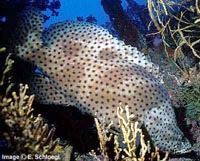Barramundi Cod

Common Name: Humpback Cod
Scientific Name: Cromileptes Altivelis
Description
The shape of the head, nape and shoulders of the Barramundi Cod closely resemble that of the Barramundi Fish (Lates calcarifer), hence its name. These fish typically have a small head, humped backs and characteristic black spots, with a creamy-grey background. They are recognised by their profile and distinctive colouration.
Diet
Barramundi Cod feed on small fish and crustaceans.
Behaviour
When alarmed, this species develops a fright colouration, with brownish blotches over the body.
Life History
Barramundi Cod are a sequential protogynous hermaphrodite, maturing firstly as females before later changing sex to males. Female Barramundi Cod are sexually mature at 39cm and grow up to 70 cm (5kg). Males 'mature' after they change sex, which occurs at various sizes for each fish..
Habitat
The Barramundi Cod prefers reef environments along the Great Barrier Reef from the Capricorn-Bunker reef groups in central Queensland to the Torres Strait. Large Barramundi Cod commonly allow themselves to become tide-bound in the shallow coral pools of Barrier Reef cays, such as the Fairy Pools on Heron Island's north-eastern reef-flat or those on the northern face of Wistari Reef. It is also known to inhabit caves and crevices of coral reefs. Juveniles live in shallow protected reefs while adult cods can be found at depths around 40m.
Special Features or Habits
Barramundi Cod are a sequential protogynous hermaphrodite, maturing firstly as females before later changing sex to males.
Location or Region Found
Western Pacific: southern Japan to Palau, Guam, New Caledonia and southern Queensland, Australia. Eastern Indian Ocean: Nicobar Islands to Broome, Western Australia.
 Deep Sea Crabs
Deep Sea Crabs